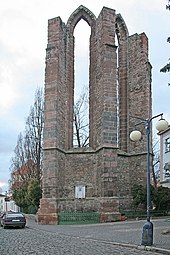Benešov
| Benešov | ||||
|---|---|---|---|---|
|
||||
| Basic data | ||||
| State : |
|
|||
| Region : | Středočeský kraj | |||
| District : | Benešov | |||
| Area : | 4686 ha | |||
| Geographic location : | 49 ° 47 ' N , 14 ° 41' E | |||
| Height: | 360 m nm | |||
| Residents : | 16,656 (Jan 1, 2019) | |||
| Postal code : | 256 01 | |||
| structure | ||||
| Status: | city | |||
| Districts: | 15th | |||
| administration | ||||
| Mayor : | Jaroslav Hlavnička (as of 2018) | |||
| Address: | Masarykovo nám. 100 256 01 Benesov |
|||
| Municipality number: | 529303 | |||
| Website : | www.benesov-city.cz | |||
Benešov (German: Beneschau ) is a city in the Central Bohemian Region , 37 km southeast of Prague. It is also the capital of the Okres Benešov of the same name and an important center of administration, education, transport and trade.
history
In connection with the consolidation of the power of the Přemyslids , the first colonists settled on the Karlov Hill around 1050. A message from the 17th century refers to a church that existed in 1070. The first written mention of Benešov comes from 1226, when it was owned by the Lords of Beneschau , who set up a rectangular market here. In 1246 the Prague cathedral provost Tobias von Benešov, an uncle of the later Prague bishop Tobias von Bechin , founded a minorite monastery . Around 1300 the Beneschowitzers moved their seat to the nearby Konopischt Castle . Their property fell to the Lords of Sternberg in 1327 , whose coat of arms is still the coat of arms of Beneschau today. In 1420 the city, which was then mostly German-populated, was conquered by the Hussites and burned down.
Several political negotiations took place in Beneschau in the late Middle Ages . B. 1451 and 1473, when the Bohemian Landtag met here. In the 15th and 16th centuries the city experienced an economic boom, especially due to its location on the trade route from Prague to Linz . There have been several changes of ownership since the end of the 16th century. During the Thirty Years' War , the population suffered much from the passing of Polish and Swedish troops. To promote re-catholicization and to improve education, Karl Přehořovský von Kvasejowitz founded a Piarist college with a grammar school in 1703 . In the 19th century, Beneschau, which bought itself out of subservience in 1802, developed into a center of national rebirth . In 1850 it became the seat of a district court ( judicial district Beneschau ).
In 1871, Beneschau received a railway connection, which was expanded into a traffic junction in 1895.
Until the end of the First World War , Beneschau was a garrison town of the Austro-Hungarian monarchy. The 2nd Battalion of the Bohemian Infantry Regiment No. 102 and the 2nd Battalion of the kk Landwehr Infantry Regiment No. 28 were located here . Due to fears of possible political unrest, the 2nd Regiment of the Tyrolean Kaiserjäger with its replacement troops of Bolzano relocated to Beneschau.
During the Second World War , the city was temporarily evacuated because the Waffen-SS operated the SS military training area in Bohemia in the area of Neweklau .
Significant industrialization only began after 1945 with the establishment of a construction machinery factory and the food industry.
City structure
The town of Benešov consists of the districts Baba, Bedrč, Benešov, Boušice, Buková Lhota, Červený Dvůr, Dlouhé Pole, Chvojen, Konopiště, Mariánovice, Okrouhlice, Pomněnice, Radíkovice, Úročnice and Vidlákova Lhotakova.
Attractions
- The St. Anna Church of the Piarist College was built between 1705 and 1715 according to plans by the architect Giovanni Battista Alliprandi .
- Konopiště Castle , two kilometers west of the city in the Konopiště district
- Old Jewish Cemetery and New Jewish Cemetery
Personalities
sons and daughters of the town
- Jaroslaus Schaller (1738–1809), Bohemian piarist, historian and topographer
- Józef Javurek (1756–1840), pianist, conductor and composer
- Karel Nový (1890–1980), Czech writer and journalist
- Vladimír Hirsch (* 1954), Czech musician
- Miroslav Beránek (* 1957), football player and coach
- Luboš Račanský (* 1964), Czech sports shooter
- Miroslav Januš (* 1972), Czech sports shooter
- Jiří Štajner (* 1976), Czech football player
Lived and worked in Benešov
- Michael Schwenke (1563–1610), main representative of the outstanding school of sculpture
- Jakub Husník (1837–1916), painter, drawing teacher and inventor of the improved collotype (new reproduction technique of printing from the surface)
- Emanuel Engel (1844–1907), Czech doctor and politician
- Josef Suk (1874–1935), Czech composer and violinist
- Emil Artur Longen (1885–1936), Czech director, dramaturge, painter, author
- Salo Flohr (1908–1983), important chess grandmaster




